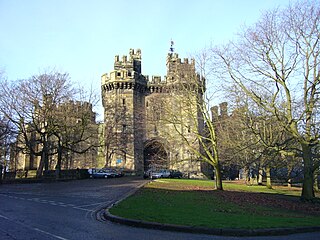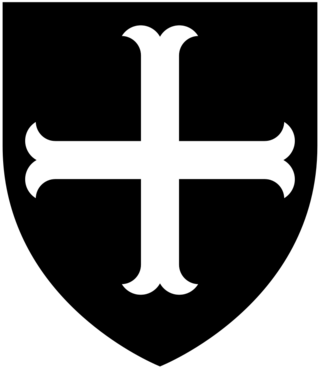William King (1663–1712) was an English poet.

The Salem witch trials were a series of hearings and prosecutions of people accused of witchcraft in colonial Massachusetts between February 1692 and May 1693. More than 200 people were accused. Thirty people were found guilty, nineteen of whom were executed by hanging. One other man, Giles Corey, died under torture after refusing to enter a plea, and at least five people died in the disease-ridden jails.
The Witchcraft Acts were a historical succession of governing laws in England, Scotland, Wales, Ireland, and the British colonies on penalties for the practice, or—in later years—rather for pretending to practice witchcraft.

The Bury St Edmunds witch trials were a series of trials conducted intermittently between the years 1599 and 1694 in the town of Bury St Edmunds in Suffolk, England.
Bertrand Guilladot or "Guillaudot" was a French priest and an alleged sorcerer. Guilladot was among the last people to be executed for witchcraft in France. He was the central figure in the Lyon witch trials that lead to the execution of several men for witchcraft in Dijon and Lyon between 1742 and 1745.
Florence Newton was an alleged Irish witch, known as the "Witch of Youghal", who died during what St John Seymour said was one of the most important examples of Irish witch trials.
The Islandmagee witch trials were two criminal trials in Carrickfergus in 1711 for alleged witchcraft at Islandmagee. It is believed to have been the last witch trial to take place in Ireland.

The trials of the Pendle witches in 1612 are among the most famous witch trials in English history, and some of the best recorded of the 17th century. The twelve accused lived in the area surrounding Pendle Hill in Lancashire, and were charged with the murders of ten people by the use of witchcraft. All but two were tried at Lancaster Assizes on 18–19 August 1612, along with the Samlesbury witches and others, in a series of trials that have become known as the Lancashire witch trials. One was tried at York Assizes on 27 July 1612, and another died in prison. Of the eleven who went to trial – nine women and two men – ten were found guilty and executed by hanging; one was found not guilty.

The Samlesbury witches were three women from the Lancashire village of Samlesbury – Jane Southworth, Jennet Bierley, and Ellen Bierley – accused by a 14-year-old girl, Grace Sowerbutts, of practising witchcraft. Their trial at Lancaster Assizes in England on 19 August 1612 was one in a series of witch trials held there over two days, among the most infamous in English history. The trials were unusual for England at that time in two respects: Thomas Potts, the clerk to the court, published the proceedings in his The Wonderfull Discoverie of Witches in the Countie of Lancaster; and the number of the accused found guilty and hanged was unusually high, ten at Lancaster and another at York. All three of the Samlesbury women were acquitted.
Sir Humphrey Winch (1555–1625) was an English-born politician and judge. He had a distinguished career in both Ireland and England, but his reputation was seriously damaged by the Leicester witch trials of 1616, which resulted in the hanging of several innocent women.
Roger Utlagh, or Roger Outlawe was a leading Irish cleric, judge and statesman of the fourteenth century who was Prior of Kilmainham, and held the office of Lord Chancellor of Ireland. He was the brother-in-law of the celebrated Witch of Kilkenny, Alice Kyteler, and is mainly remembered today for his efforts to shield her from prosecution, and subsequently enabling her to escape punishment, during the Kilkenny Witch Trials of 1324.
Nicholas Nugent was an Anglo-Irish judge, who was hanged for treason by the government that appointed him. He had, before his downfall, enjoyed a highly successful career, holding office as Solicitor General for Ireland, Baron of the Irish Court of Exchequer, and Chief Justice of the Irish Common Pleas, but he was ruined by the rebellion of his nephew William Nugent, which he was accused of supporting.
Walter de Islip, Isleep or de Istlep was an English-born cleric, statesman, and judge in fourteenth-century Ireland. He was the first Chief Baron of the Irish Exchequer; he also held the offices of Treasurer of Ireland, Chief Escheator, and Custos Rotulorum of Kilkenny. He was a noted pluralist, who held numerous benefices. His career was seriously damaged by accusations of corruption and maladministration. He played an important role in the celebrated Kilkenny Witchcraft Trials of 1324.
James Macartney was an Irish lawyer, judge and politician, notable mainly for presiding at the Islandmagee witch trial of 1711, which was apparently the last such trial in Ireland.
The Honourable Thomas Coote was an Irish politician and judge, who sat in the Irish House of Commons, and held office as Recorder of Dublin and as a judge of the Court of King's Bench (Ireland). Although he was generally liked and respected, he was removed from the Bench in 1714, and resumed his political career. He was the grandfather of the Earl of Bellomont, and a noted bibliophile.
Sir William Aston (1613-1671) was an English-born barrister, politician and soldier, who fought with distinction in Ireland for King Charles I during the English Civil War. Although he made his peace with the Cromwellian regime after the King's defeat, he is believed to have remained a convinced Royalist at heart. He was rewarded for his loyalty to the Crown with a seat on the Irish High Court Bench after the Restoration. His eldest son was hanged for murder in 1686. His last direct male descendant, also named William Aston, was the de jure 6th Lord Aston of Forfar.
The Leicester boy trial was one of Leicester's most notorious witchcraft cases, in which a thirteen-year-old boy publicly accused 15 women of causing a possession within him. The case took place in Husbands Bosworth, a small village not far from Leicester in 1616. John Smith fell into a series of violent fits, not even several men could hold him down. He made strange noises, and, as noted in a letter from Alderman Robert Heyrick to his brother Sir William, he would beat himself with inhuman strength, yet somehow remain unharmed. He gave extensive details on their familiars. The two judges, Sir Humphrey Winch and Sir Ranulph Crewe quickly condemned the women, rounding all 15 of them up. Nine of them were tried, found guilty and hanged for allegedly possessing John Smith. The other six were placed in prison to wait their turn. None of them were named before being hanged. King James I happened to be passing through about a month later, and heard what was going on. He called for John Smith to be questioned, and had little trouble determining the child was fraudulent. He broke down, and confessed the truth. Of the six women who had been imprisoned, only five of them were released, as one of them died inside. According to a timeline, the woman who had died told the jailer she was working with the witches against Smith the day before she died. She had begged him not to say anything because the witches would harm her.

John Upton (1639–1687) of Lupton in the parish of Brixham in Devon, was a Member of Parliament for Dartmouth in Devon from February 1679 to August 1679.
Witch trials and witch related accusations were at a high during the early modern period in Britain, a time that spanned from the beginning of the 16th century to the end of the 18th century.
Mary Butters was an Irish witch known as the Carnmoney witch.





